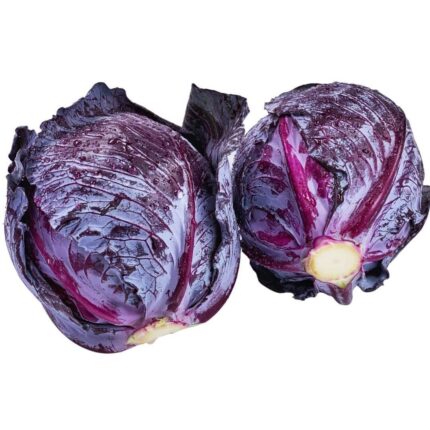12 – 14 pieces
40-50 lbs per bag
Seasonally sourced from Canada, Florida, Georgia, and New York
Green Cabbage aka “Bagged Cabbage”, “Cannonball Cabbage”, “Juan-Xin-Cai”, “Yang-Bao-Cai”, “Dai-Zhuang-Bao-Cai”, “卷心菜”, “洋包菜”, “袋装包菜”
Green cabbage has wide fan-like leaves in green with a slightly rubbery texture when raw. The leaves fade to light yellow and white in the center. Raw leaves are somewhat peppery in flavor, but the cabbage gets sweeter as it cooks. Common application includes salad and stir-fry. Green cabbage is available year-round.
Handling Tip
Selection
Green cabbage should be firm and heavy for its size.
Leaves are tightly packed without any bruises.
Green cabbage heads squeak when rubbed together, which means that they are crisp and fresh.
The presence of a waxy bloom on the leaves is desirable.
Storage
Green cabbage should be stored at 32°F (0°C) with a relative humidity of ninety-eight percent to a hundred percent with mist.
The typical shelf life is three to six months. High humidity is important to avoid wilting.
Green cabbage is sensitive to ethylene, a naturally occurring gas that regulates ripening. Green cabbage should not be stored with high ethylene-producing products to extend shelf life and avoid quality loss such as leaf yellowing, wilting, and abscission. Green cabbage produces a low level of ethylene.
Green cabbage is not sensitive to chilling injury. The freezing point for green cabbage is 30.4°F – 30.5 °F (-0.9°C – -0.83°C). Storage at 30.2°F (-1°C) is not advisable because it can produce freeze damage, especially on outer leaves.
Nutrition Fact
Serving Size 1/12 medium head (84g)
Amount Per Serving % Daily Value*
Calories 25
Calories from Fat 0
Total Fat 0g ……………………………………………………………………………….. 0%
Saturated Fat 0g ……………………………………………………………….. 0%
Trans Fat 0g ………………………………………………………………………. 0%
Cholesterol 0mg ………………………………………………………………………. 0%
Sodium 20mg …………………………………………………………………………… 1%
Total Carbohydrate 5g ……………………………………………………………. 2%
Dietary Fiber 2g ……………………………………………………………….. 8%
Sugar 3g
Protein 1g
Vitamin A …………………………………………………………………………………….. 0%
Vitamin C …………………………………………………………………………………… 70%
Calcium ………………………………………………………………………………………… 4%
Iron ………………………………………………………………………………………………. 2%
Potassium ……………………………………………………………………………………. 5%
*The % Daily Value (DV) tells you how much a nutrient in a serving of food contributes to a daily diet 2,000 calories a day is used for general nutrition advice.
*Based on information published by FDA
Creating clear and transparent shipping and handling policies is crucial for a commodity trading company like Agropastoral Products Co., Ltd. Here's a framework for the Shipping and Handling Policy:
1. Shipping Policy:
a. Shipping Process: - Detail the steps involved in the shipping process, from order placement to delivery.
b. Shipping Rates: - Specify the shipping costs associated with various products or order amounts.
c. Delivery Timeframe: - Provide estimated delivery times based on location and shipping method.
d. Shipping Carriers: - Name the shipping carriers used and any partnerships that may influence shipping.
e. International Shipping: - Explain international shipping options, rates, and potential customs or import duties.
f. Tracking Information: - Describe how customers can track their orders and obtain tracking information.
g. Shipping Restrictions: - List any countries, regions, or products where shipping may be restricted or limited.
2. Handling Policy:
a. Packaging: - Describe how products are packaged to ensure safe transit and delivery.
b. Quality Assurance: - Explain any quality control measures or checks in place during the handling process.
c. Fragile Items: - Provide special handling instructions for fragile or delicate commodities.
d. Inventory Management: - Detail how inventory is managed to maintain accuracy and prevent errors in order fulfillment.
e. Returns and Exchanges: - Outline the process for handling returns, exchanges, or replacements related to shipping issues or damaged items.
3. Additional Policies:
a. Lost or Damaged Items: - Explain the procedure for reporting and addressing lost or damaged items during shipping.
b. Split Shipments: - Describe under what circumstances the company may split an order into multiple shipments and how this is communicated to the customer.
c. Free Shipping Offers: - Clarify conditions for free shipping, such as minimum order amounts or specific products.
d. Holiday or Peak Season Shipping: - Provide information about any special considerations or delays during peak seasons or holidays.
e. Force Majeure: - Address how the company handles unforeseen events like natural disasters, strikes, or other force majeure events affecting shipping and delivery.
f. Contact Information: - Provide contact details for customers to reach out for shipping-related queries, concerns, or support.
Regularly update and review these policies to ensure they align with your company's operations and any changes in shipping or handling processes. Communicating these policies clearly to your customers will help manage their expectations and provide a positive shopping experience.













Reviews
There are no reviews yet.